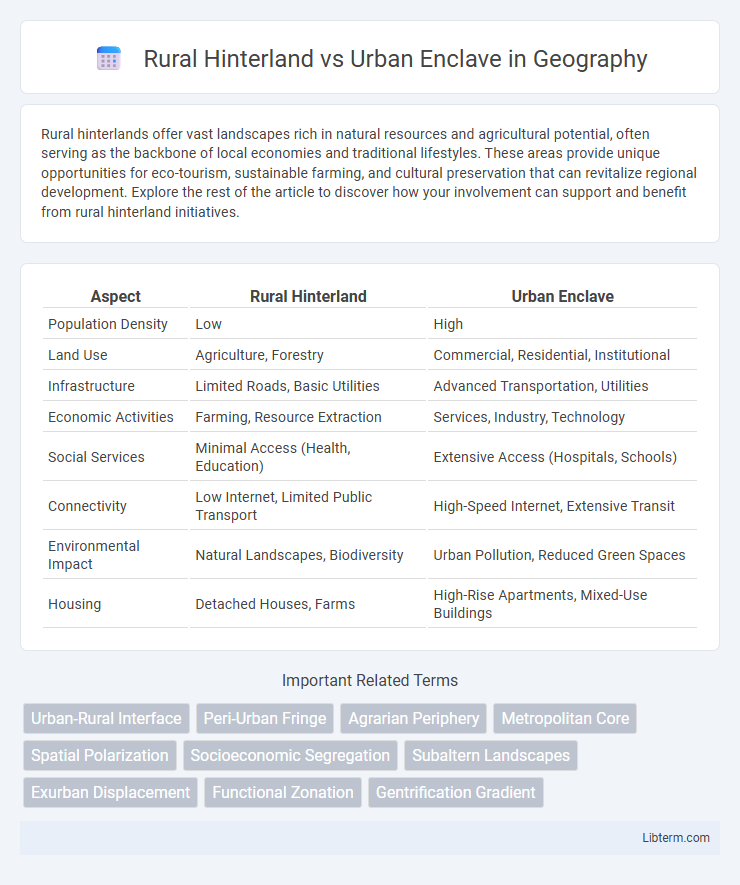Rural hinterlands offer vast landscapes rich in natural resources and agricultural potential, often serving as the backbone of local economies and traditional lifestyles. These areas provide unique opportunities for eco-tourism, sustainable farming, and cultural preservation that can revitalize regional development. Explore the rest of the article to discover how your involvement can support and benefit from rural hinterland initiatives.
Table of Comparison
| Aspect | Rural Hinterland | Urban Enclave |
|---|---|---|
| Population Density | Low | High |
| Land Use | Agriculture, Forestry | Commercial, Residential, Institutional |
| Infrastructure | Limited Roads, Basic Utilities | Advanced Transportation, Utilities |
| Economic Activities | Farming, Resource Extraction | Services, Industry, Technology |
| Social Services | Minimal Access (Health, Education) | Extensive Access (Hospitals, Schools) |
| Connectivity | Low Internet, Limited Public Transport | High-Speed Internet, Extensive Transit |
| Environmental Impact | Natural Landscapes, Biodiversity | Urban Pollution, Reduced Green Spaces |
| Housing | Detached Houses, Farms | High-Rise Apartments, Mixed-Use Buildings |
Defining Rural Hinterlands and Urban Enclaves
Rural hinterlands refer to expansive, low-density areas characterized by agricultural land, natural resources, and small communities that support urban centers economically and culturally. Urban enclaves denote dense, distinct neighborhoods within cities marked by unique social, ethnic, or economic characteristics, often functioning as self-contained units with localized services. Understanding these spatial dynamics highlights the contrast between dispersed rural economies and concentrated urban social structures.
Historical Evolution of Rural and Urban Spaces
Rural hinterlands historically served as agricultural zones supporting urban centers, with economies rooted in farming and resource extraction, while urban enclaves evolved as centers of commerce, culture, and governance. Industrialization in the 19th century accelerated urban growth, transforming rural areas through mechanization and migration patterns that reshaped demographic distributions. Modern spatial dynamics reflect the historical layering of infrastructure, land use, and socio-economic functions distinguishing rural hinterlands from densely populated urban enclaves.
Socio-Economic Dynamics: Contrasts and Intersections
Rural hinterlands typically exhibit lower population density and rely heavily on agriculture and natural resource extraction, resulting in limited access to advanced infrastructure and services, which contrasts sharply with urban enclaves characterized by high population density, diverse economic activities, and robust access to education, healthcare, and technology. Socio-economic dynamics reveal disparities in income levels, employment opportunities, and social mobility, yet intersections occur through migration patterns, cultural exchanges, and evolving economic linkages that blur strict rural-urban boundaries. Understanding these contrasts and intersections enhances policy formulation aimed at balanced regional development and sustainable economic growth.
Infrastructure and Access to Services
Rural hinterland areas typically face limited infrastructure development and restricted access to essential services such as healthcare, education, and public transportation, leading to challenges in connectivity and economic growth. Urban enclaves benefit from advanced infrastructure, including extensive road networks, public transit systems, reliable utilities, and proximity to hospitals, schools, and commercial centers, enhancing residents' quality of life and service accessibility. The disparity in infrastructure investment between rural hinterlands and urban enclaves significantly influences social equity, economic opportunities, and overall regional development.
Cultural Identity and Community Life
Rural hinterlands often maintain strong cultural identities rooted in traditional practices, local dialects, and closely-knit community life, fostering deep social bonds and shared heritage. Urban enclaves exhibit diverse cultural identities shaped by immigrant populations and multicultural influences, creating vibrant, dynamic communities with distinct social networks and communal activities. The contrast between rural cohesion and urban diversity highlights different expressions of cultural identity and community engagement shaped by geographic and social environments.
Environmental Impact and Land Use Patterns
Rural hinterlands experience lower environmental degradation due to sparse population density and extensive natural land cover promoting biodiversity, while urban enclaves face intense land use pressures causing habitat fragmentation and increased pollution. Agricultural practices dominate rural land use, resulting in significant soil management and water resource concerns, whereas urban enclaves prioritize infrastructure development, leading to impervious surfaces and heat island effects. The spatial juxtaposition of these areas highlights contrasting environmental footprints shaped by differing land utilization and anthropogenic activities.
Migration Trends: Push and Pull Factors
Rural hinterlands experience migration outflows driven by push factors such as limited economic opportunities, inadequate infrastructure, and lower access to education and healthcare, compelling residents to seek better livelihoods. Urban enclaves attract migrants through pull factors including job availability in diverse industries, advanced services, social networks, and higher living standards. These migration trends result in demographic shifts, economic disparities, and spatial reorganization within regions.
Economic Opportunities and Employment Gaps
Rural hinterlands often face limited economic opportunities due to lower industrial diversity and reduced infrastructure investment, resulting in higher unemployment rates and underemployment compared to urban enclaves. Urban enclaves benefit from concentrated industries, innovation hubs, and robust service sectors, fostering diverse employment options and attracting skilled labor. This disparity creates significant employment gaps, with rural areas struggling to retain talent and achieve sustainable economic growth.
Policy Challenges and Development Strategies
Rural hinterlands face policy challenges such as limited infrastructure, lower access to healthcare and education, and economic dependency on agriculture, requiring development strategies that prioritize connectivity, diversification, and community-based resource management. Urban enclaves experience issues like spatial segregation, unequal access to services, and social exclusion, necessitating strategies focused on inclusive urban planning, affordable housing, and integrated public transport systems. Effective policies must address disparities by tailoring initiatives to the socio-economic contexts, promoting sustainable growth through participatory governance and equitable resource allocation.
Future Prospects: Bridging the Rural-Urban Divide
Future prospects for bridging the rural-urban divide hinge on enhancing infrastructure, digital connectivity, and sustainable economic opportunities within both rural hinterlands and urban enclaves. Investments in smart agriculture technologies and decentralized renewable energy can foster rural development, while urban planning focused on inclusivity and affordable housing addresses urban enclave challenges. Collaborative policies leveraging data-driven insights will be critical to creating integrated regional networks that promote equitable growth and mobility.
Rural Hinterland Infographic

 libterm.com
libterm.com